NGONG PING
NGONG PING 360 CABLE CAR TEMPORARY CLOSURE - The Ngong Ping 360 cable car operating between Tung Chung and Ngong Ping is to close for scheduled maintenance from 2nd to 16th September 2025 inclusive. During the closure period Ngong Ping Village, the "Big Buddha", Po Lin Monastery and other attractions at Ngong Ping remain open as usual. For alternative transport between Tung Chung and Ngong Ping, New Lantao Bus Company service 23 takes about 50 minutes and departs from Tung Chung Tat Tung Road Bus Terminus or Lantau (blue) taxi, fare approx HK$240, journey time about 35 mins.
NGONG PING “WISDOM PATH” TEMPORARY CLOSURE - The “Wisdom Path” at Ngong Ping will be closed for refurbishment work from 5th June 2025. It will gradually reopen in phases with final completion of refurbishment expected to be in the final quarter of 2026.
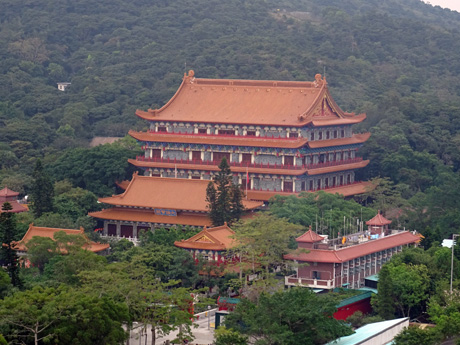
View over Po Lin Monastery on the Ngong Ping plateau viewed from the podium of the "Big Buddha" statue. The monastery's new Grand Hall of Ten Thousand Buddhas,opened in October 2014, can be seen towering over the other monastery buildings
Ngong Ping, also known as "Ngong Ping Plateau" is a flat terrain of 102-hectares in the central part of Lantau Island, 460-metres above sea level. It is a scenic location with several religious sites flanked by mountains to the north, south and east, where Lantau Peak at 934-metres, Hong Kong’s second highest mountain towers above. To the west, the plateau faces the coast. Ngong Ping is the location of Po Lin Monastery, one of Hong Kong’s most famous Buddhist monasteries, founded in 1906, and once a remote and peaceful place. However, since the monastery opened its main hall in 1970, followed by construction of the adjacent Tian Tan “Big Buddha” statue in 1993 and Ngong Ping 360 cable car and Ngong Ping Village in 2006 it has become one of Hong Kong’s most popular tourist destinations.
TIAN TAN BUDDHA STATUE (BIG BUDDHA)
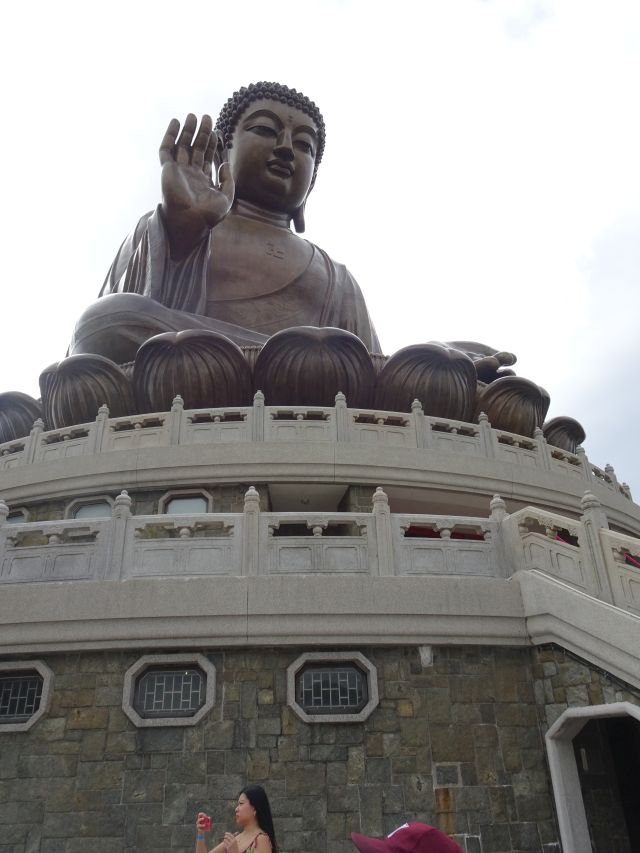
The "Big Buddha" sits high up on a podium, dominating the surrounding area
The Tian Tan (Altar of Heaven) “Big Buddha” statue was completed in 1993 having taken over ten years to construct at a cost of HK$60 million. It weighs 250 tonnes and was cast in 202 bronze sections in Mainland China by satellite and rocket manufacturers China Astronomical Industry Scientific and Consultative Corporation of Nanjing. The castings were transported over a period of three years to Lantau, where it was assembled. The Buddha’s face was cast in a single section. The statue replaced an earlier Buddha statue on the site. The statue stands 26 metres high on a circular three-tier podium and is hollow, supported by a steel framework. It is claimed to be “the world’s largest seated outdoor bronze Buddha statue”. To reach the Buddha involves climbing some 268 steps to the lower tier of the podium. There is a less steep access road leading to the car park just below the lower tier, from where access to the Buddha podium is by either wheelchair ramp or a short flight of steps. However, the access road and car park are accessible only to tour coaches and authorised vehicles, but not taxis. People with mobility difficulties who are unable to climb the steps can request assistance from the main office at adjacent Po Lin Monastery.
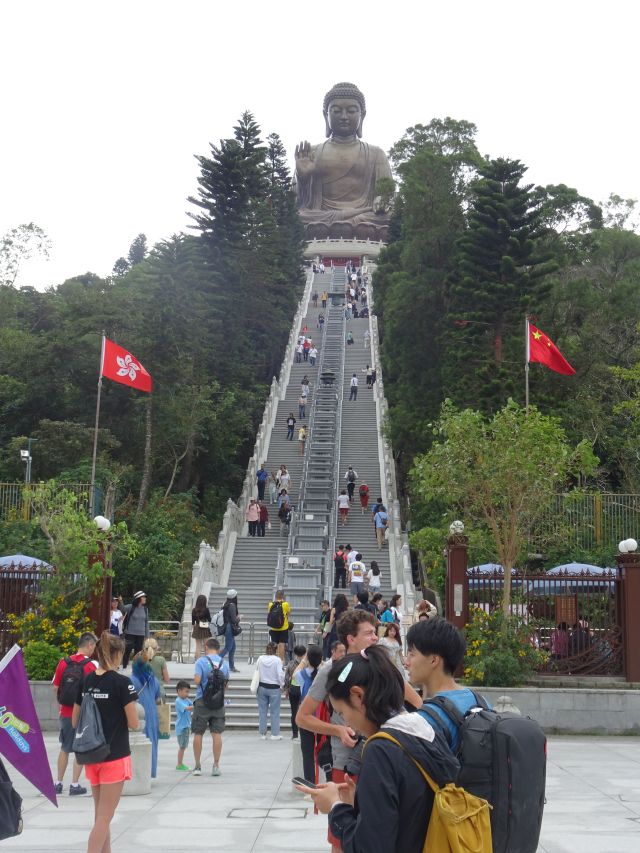
Visitors need to climb 268 steps to reach the Buddha statue.
Around the lower tier sit six two-tonne bronze Bodhisattva statues making offerings to the Buddha. The panoramic views from the podium are outstanding when the area is not shrouded in mist and cloud.
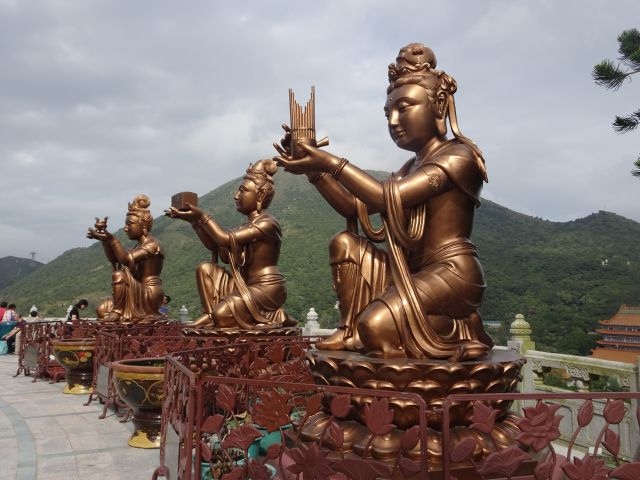
Bronze Bodhisattva's making offerings sit around the podium, on the lower level tier at the top of the steps
Inside the podium underneath the statue is a museum on three levels, with exhibition halls, the Hall of Remembrance”, “Hall of Benevolent Merit” and “Hall of Universe”, where exhibits include a large bell with carved Buddha images, which is rung every seven minutes, 108 times daily to symbolise the clearing of 108 worries, oil paintings and Gautama Buddha relics.

The bell inside the Buddha statue, seen from above
The highlight of the museum is the Buddha's bone relic on the third floor. The Buddha relic refers to the coloured crystals left after the Buddha entered paranirvana. There are three types of relic by colour. White is the bone relic, Black is the hair relic and Red is flesh relic. The bone relic worshipped at Po Lin Monastery was gifted to the monastery in 1992 by a famous monastery in Sri Lanka. Photography is not allowed in the museum and the Buddha relic is viewed from a distance.
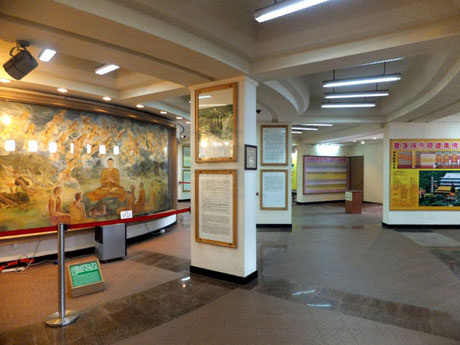
Second floor of the museum inside the podium of the Buddha statue. The highlight of the museum is the Buddha's bone relic
The Buddha statue is open daily from 10am to 5-30pm. Admission to the Buddha and museum is free.
PO LIN MONASTERY
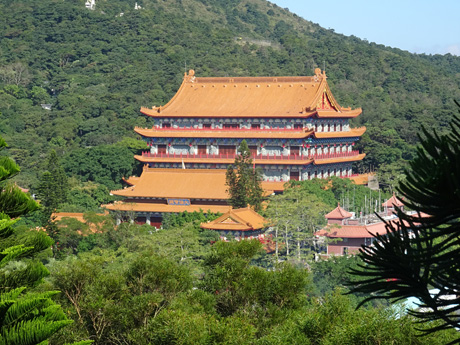
Po Lin Monastery. The building dominating the background to this picture is the Grand Hall of Ten Thousand Buddhas, completed in October 2014, which towers over the existing monastery buildings
The monastery was founded in 1906 by three Zen masters of Jin Shan Monastery of Zhenjiang, Jiangsu Province in China who had travelled south to Lantau Island to spread the Buddhist doctrine. The monastery was originally simply a stone thatched house without a name but as more and more monks gathered there a large hut was built to accommodate them. At the invitation of the three Zen masters, Monk Jixiu of Jin Shan Monastery became the first abbot in 1924 changed the name of the hut to “Po Lin Monastery”, Po Lin meaning “Precious Lotus”. One of the monastery's former abbots was the eminent monk Venerable Fat Hot (1893-1972), who was appointed in 1930 and expanded the monastery greatly. In December 1941, when Hong Kong was under Japanese occupation and the monastery was desperately short of food, Venerable Fat Hot travelled to Guangzhou to publicise Buddhism and beg for alms and during this time founded the Hong Kong Buddhist Association and established a charitable school and Buddhist hospital. He resigned as abbot in 1952 but resumed the post again one year later. Venerable Fat Hot died in 1972 and is buried in the mountain at the back of the monastery. Since then, the monastery has further and been a major draw for tourists and locals since its main hall opened in 1972. Construction of the Tian Tan Buddha statue, which was completed in 1993 and the opening of the Ngong Ping 360 cable car system and Ngong Ping Village in 2006 have made it one of Hong Kong's busiest attractions and a further major expansion, completed in late 2014 includes the large five storey Grand Hall of Ten Thousand Buddhas has been under way since 2007. A grand opening ceremony of the new temple took place in December 2013, to celebrate the 20th birthday of the “Big” Buddha statue, and the temple finally opened to the public in October 2014.
The monastery is currently home to about 100 monks and nuns.
At the entrance to the monastery is large triple arch white stone "Mountain Gate" pai lau adorned with three pagoda statues leading to a wide approach pathway lined with bauhinia. This pai lau has been part of the monastery ever since it opened and has been moved several times. A second pai lau was erected in 2010 as part of the Ngong Ping Piazza development.
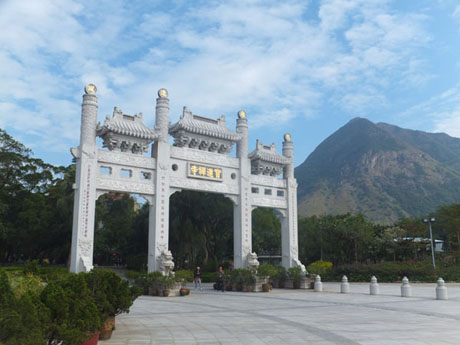
The original triple-arch stone "Mountain Gate" pai lau at the entrance to the monastery at Ngong Ping Piazza.
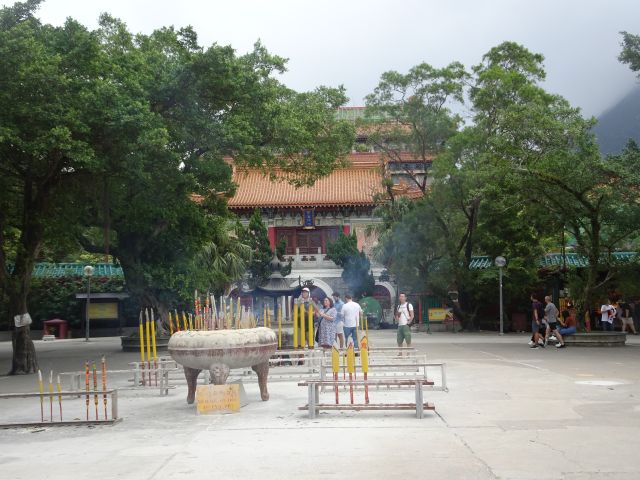
Incense burning outside the monastery entrance
Along the path from the piazza to Po Lin Monastery is a 4.1 metre cauldron seated on a pedestal. The Reunification Cauldron was erected in 1998 and commemorates the end of British sovereignty and return of Hong Kong to the motherland a year earlier. The cauldron is engraved with the pattern of the Bauhinia, the national emblem of Hong Kong. The cauldron was originally located in Di Tan Square but was moved to its present location during construction works for the piazza.
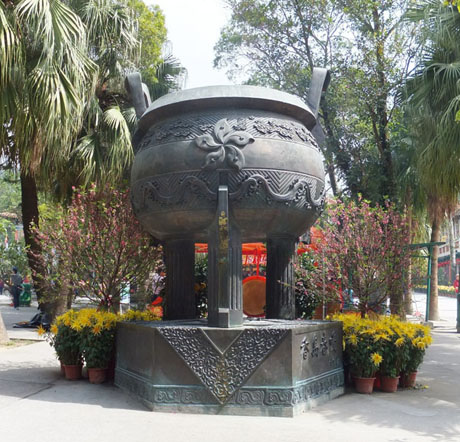
The brass Reunification Cauldron, commemorates the return of Hong Kong to the People's Republic of China and the end of British sovereignty. It is embossed with bauhinia flowers, the emblem of Hong Kong
Just beyond is the two storey Welto Temple where visitors are greeted by the smiling Maitreya Buddha with Welto Bodhisattva behind. This temple acts as a sentinel for the main temple, Hall of Great Hero, beyond. Separating these temples is a colourful courtyard with pavilions, flowering trees and lotus pond.
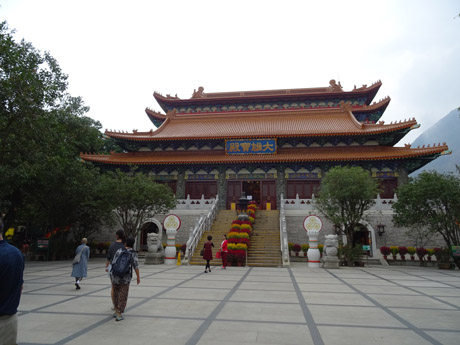
Po Lin Monastery's "Main Shine Hall of Buddha" sits in front of the new Grand Hall of Ten Thousand Buddhas, barely distinguishable in the background
The Main Shrine Hall of Buddha was completed in 1970 and is protected by a pair of stone lions. Steps lead up to the main hall where three large Buddha statues sit. These are Sakyamuni Buddha (the present Buddha), Bhaisajyaguru Buddha (the past Buddha) and Amitabha Buddha (the future Buddha). Sakyamuni Buddha is flanked by two attendants, Mahakasyapa and Ananda.
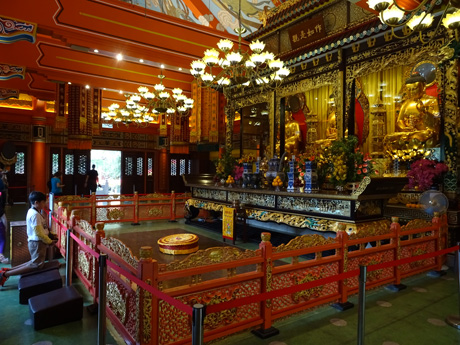
The main worship hall, redecorated in 2014, contains Buddha shrines, Bhaisayjaguru Budda (left), Sakyamuni Buddha (centre), Amitabha Buddha (right)
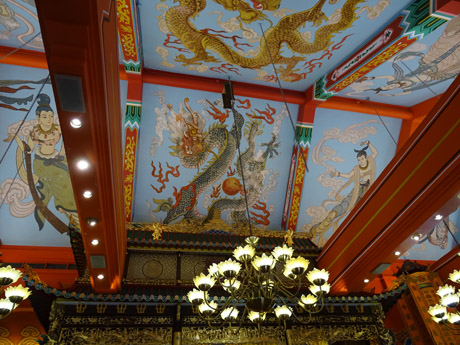
Ceiling murals in the main worship hall, redecorated in 2014
A number of smaller temples at the rear of the main hall have been demolished in recent years to make way for the huge “Grand Hall of Ten Thousand Buddhas” and “Seven Treasures Lotus Pond”, which were completed in October 2014. The Grand Hall will contain ten thousand Buddha statues, Scripture Library, Abbot’s Chamber, Dharma Hall, Permanent Ordination Hall, 3000 square-metre Exhibition Hall for precious Chinese and Buddhist relics and artefacts and a multi-purpose hall. It will also be the venue be used for study of scriptures and Buddha teachings and for teaching, contemplation and practice of Dharma and religious disciplines are taught, contemplated and practiced as well as being a platform for traditional, historical, cultural, and educational and tourism promotional activities.
The lower floor of the Grand Hall of Ten Thousand Buddhas with the five Dhiyani Buddha statues, Amoghassidi, Amitabha, Vairocana, Ratnasambhava and Aksobhay, ten thousand miniature Buddha statues lining the walls and an elaborately decorated ceiling. These can be viewed only from the hall entrance
Po Lin Vegetarian Restaurant is situated at one side of the courtyard and meal tickets can be bought at the entrance or from the souvenir kiosk at the foot of the steps leading to the "Big Buddha". A standard meal ticket cost HK$150 as at early 2025
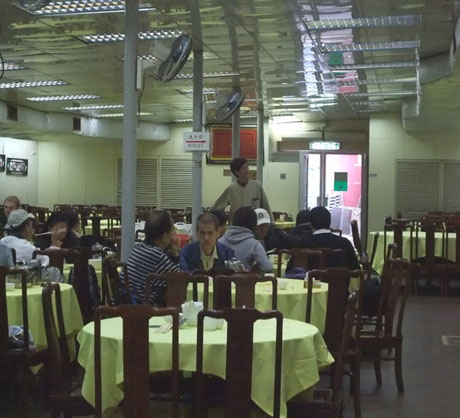
Po Lin Vegetarian Restaurant
Deli Vegetarian Café is located adjacent to Po Lin Vegetarian Restaurant, offering take away snacks which can be eaten at tables in the outdoor area outside the restaurant.
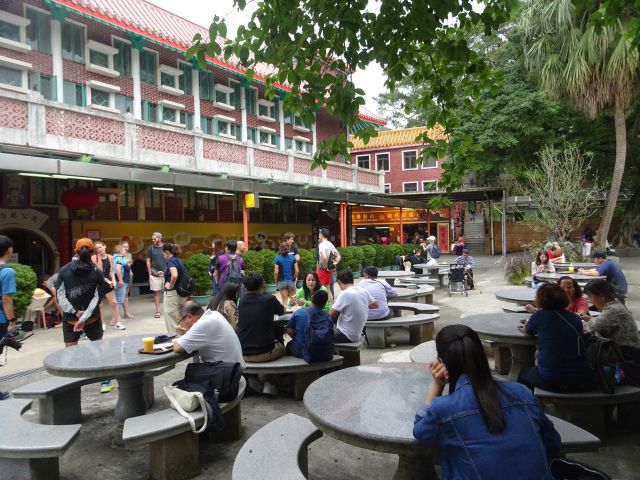
Deli Vegetarian Cafe, snack bar, next to Po Lin Vegetarian Restaurant has an outdoor partially covered seating area
OPENING HOURS;
Po Lin Monastery is open daily 8am to 6pm and entry is free.
Po Lin Vegetarian Restaurant open 11-30am to 4-30pm daily
Deli Vegetarian Café open from 11-30pm to 4-30pm daily.
WEBSITE;
http://www.plm.org.hk/
NGONG PING VILLAGE
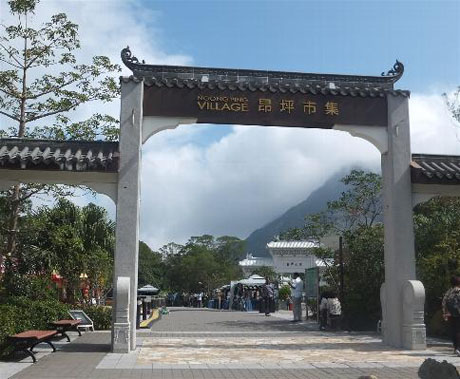
The entrance arch to Ngong Ping Village. In the distant background mist rolls over Lantau Peak, Hong Kong's second highest mountain
Opened in 2006 at the same time as the Ngong Ping 360 Cable Car system, Ngong Ping Village is the location of the Ngong Ping Cable Car Terminus, which links the village with Tung Chung. Cable cars carrying up to a maximum of 17 passengers arrive at the terminus with cabins arriving about every 30 seconds.
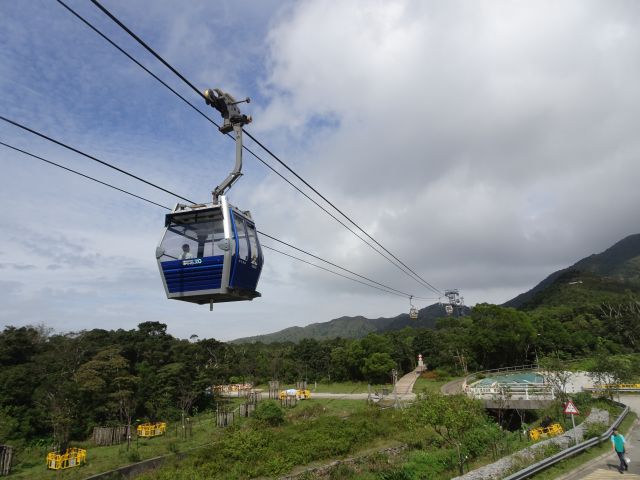
Cable car cabins arrive at the Ngong Ping Cable Car Terminus in the village every few seconds
The village is a highly commercialised “culturally themed” village in traditional Chinese architectural style just a short walk from the Po Lin Monastery and Tian Tan Buddha Statue.
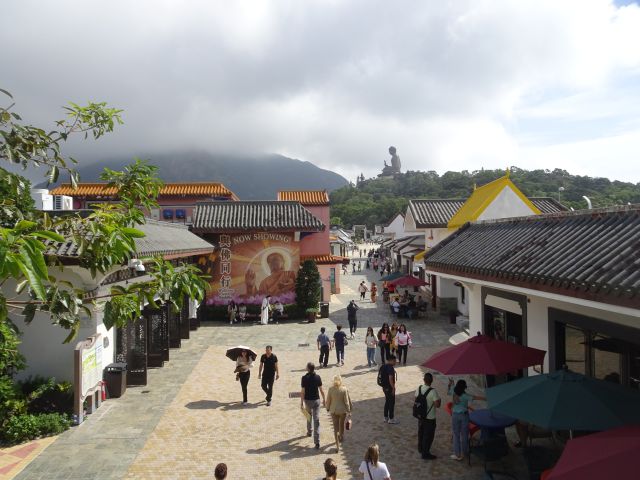
Ngong Ping Village lies in the shadow of the "Big Buddha"
The village has two multi-media theatre shows, Boddhi wishing tree, gift shops, restaurants and café’s and occasional street entertainment. The village is open Monday to Friday 10am to 6pm, weekends and public holidays 9am to 6-30pm.
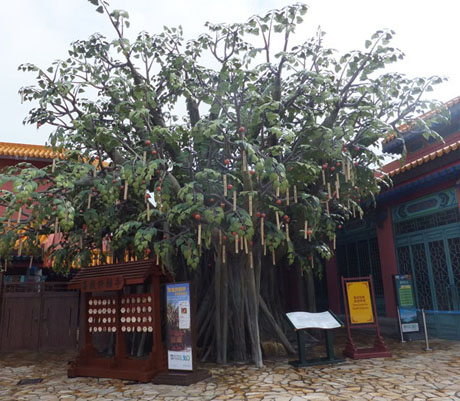
Wishing Tree at Bodhi Square in Ngong Ping Village. Wishing cards are redeemed on purchase of goods over a specified amount from souvenir shops in the village
“Walking with Buddha” is an audio-visual presentation depicting the life of Siddhartha Guatama, the man who became Buddha and follows his journey along the path to enlightenment. Permanently closed. Replaced 2025 by the Fengyun Pavilion of Chinese Dynasty The Three
Kingdoms
“Monkey’s Tale Theatre”, was a comic animation based on the famous Buddhist Jakata stories. The theatre permanently closed in late 2013
CABLE CAR DISCOVERY CENTRE
The centre, opened in 2022, features various galleries and experience zones, detailing the operation of the cable car system including an exhibition of cable car components, photo area and interactive installations including a vitual reality experience of the restricted engineering zone. The Cable Car Discovery Centre is open from 11am to 5pm daily. Admission fee at March 2025 is HK$60 adult, HK$30 child, HK$42 senior* (*Hong Kong residents only with JoyYou Card or Hong Kong Senior Citizen Card).
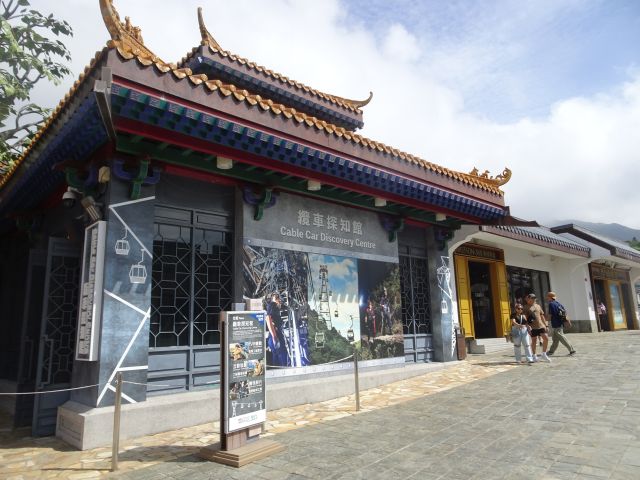
Ngong Ping 360 Cable Car Discovery Centre
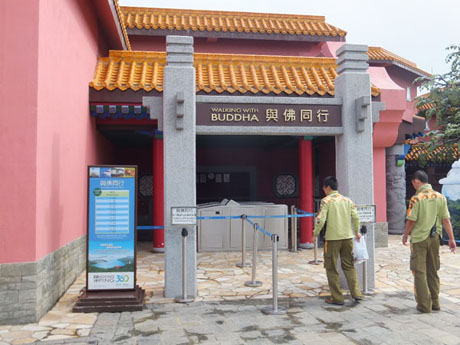
Entrance to "Walking with Buddha" multi-media presentation in Ngong Ping Village. This attraction is permanently closed. Replaced by the Fengyun Pavilion of Chinese Dynasty The Three
Kingdoms
MOTION 360
Motion 360 is an immersive theatre spaceship ride over Lantau with simulated effects. It operates between 11am and 5pm daily and runs for about 10 minutes. Admission fee at March 2025 is HK$40 adult, HK$20 child and HK$28 senior* (*Hong Kong residents only with JoyYou Card or Hong Kong Senior Citizen Card).
UPGRADE OFFER – Visitors holding one-day cable car tickets can upgrade to include Cable Car Discovery Centre or Motion 360 for a top-up fee of HK$20 (at March 2025)
FENGYUN PAVILION OF CHINESE DYNASTY THE THREE KINGDOMS
Opened in 2025 the Fengyun Pavilion of Chinese Dynasty The Three Kingdoms is an immersive multi-media attraction dedicated to the history of the Three Kingdoms period in ancient China. Spanning from approximately A.D. 220 to 280, an era characterised by intense power struggles among warlords and the rise of legendary heroes. The characters and narratives from this time are both famous and deeply ingrained in Chinese culture. The experience lasts about 30 minutes and runs between 11-00 and 16-45 daily. The admission fee at March 2025 is HK$90 with no concessions.
For further information on Cable Car Discovery Centre, Motion 360 and Fengyun Pavilion of Chinese Dynasty The Three Kingdoms see;
https://www.np360.com.hk/en/things-to-do/np-village
NGONG PING NATURE CENTRE
Ngong Ping Nature Centre was established by the Agriculture, Fisheries and Conservation Dept and seeks to promote public awareness of environmental and ecological conservation of the island through displays which are in English, Chinese and Japanese languages. The centre was reopened in November 2021 adopting a more open design following renovation. There are free daily guided nature tours from the centre. For latest information on guided tours see;
https://www.afcd.gov.hk/english/country/cou_lea/cou_lea_ven/ngongping.html
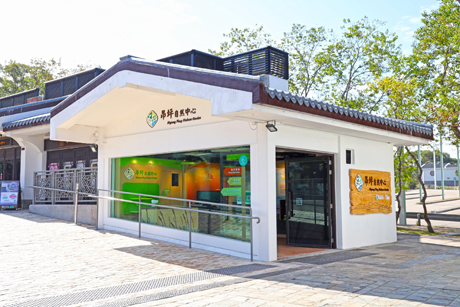
Ngong Ping Nature Centre after refurbishment in late 2021
Ngong Ping Garden Restaurant is a large Chinese restaurant on two floors specialising in Cantonese and Chiu Chow cuisine.
Linong Tea House has three daily demonstrations with Chinese music, and promotes its own connoisseur tea “Artistic Flower Tea”
Other dining establishments include Subway, Starbucks, Ebeneezer’s Kebabs, Honeymoon Dessert and Zen Noodle Café. For full details of dining outlets see;
http://www.np360.com.hk/en/np360-exp/food-beverage.html
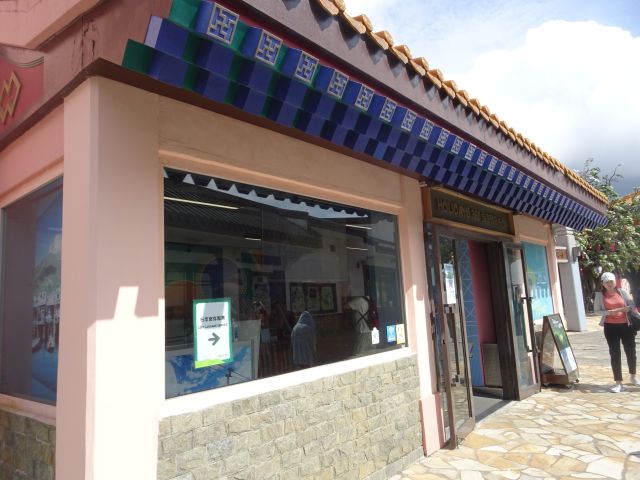
Luggage storage is available at the 360 Holidays building in Ngong Ping Village
NGONG PING PIAZZA
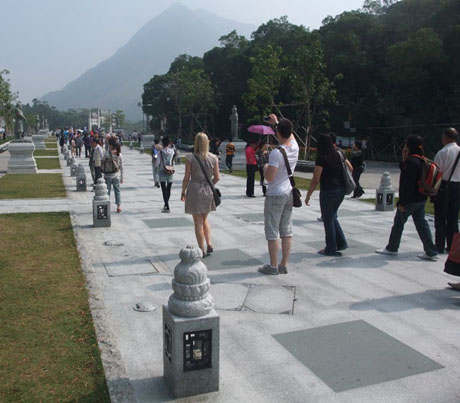
The Bodhi Path at the new Ngong Ping Piazza, opened in 2010
A recent development linking Ngong Ping Village with other tourist attractions at Ngong Ping including the "Big Buddha", Po Lin Monastery and Wisdom Path is Ngong Ping Piazza, completed in July 2010 as part of a programme to enhance public facilities at Ngong Ping. The piazza, which was almost two years in construction and cost some HK$77.5 million, is intended to harmonise with the religious setting of the surrounding environment and includes a new 14.1 metre tall, 19.1 metre wide Pai Lau, 122 metre long Bodhi Path flanked by statues of the "Twelve Divine Generals".
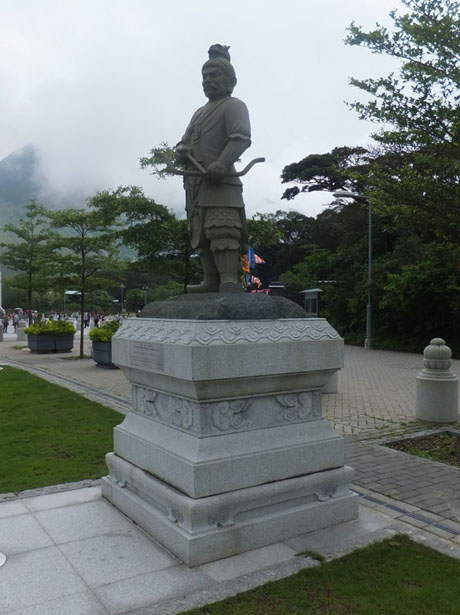
One of the "Twelve Divine Generals" lining the Bodhi Path at Ngong Ping Piazza
Below the Buddha in Ngong Piazza is Di Tan (the Altar Of Earth), a circular granite podium with four lotus ponds, where the monastery holds major ceremonies. Di Tan is connected to Tian Tan (the Altar of Heaven) by the 268 steps leading to the Buddha. with four lotus ponds. The piazza also has a 1,980 sq metre Chinese landscaped garden and pavilion.
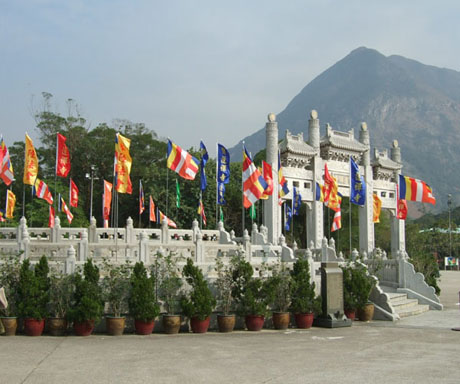
Di Tan (Altar of Earth) at Ngong Ping Piazza is connected to Tian Tan (Altar of Heaven) by the 268 steps leading to the Buddha
NGONG PING TEA GARDEN
Located alongside the path from the “Big Buddha” to the Wisdom Path, the tea plantation was established in 1947 by Brook Bernacchi, a prominent British barrister and politician, the first European to settle on Lantau Island and son of the explorer Lieutenant Commander Louis Bernacci who accompanied Robert Falcon Scott to the Arctic as well as his own expeditions to Antarctica and South America. Brook Bernacci had purchased a small nunnery at Ngong Ping and turned into his home, which can still be seen behind the Tea Gardens Restaurant. He established Hong Kong’s only tea plantation nearby to give work to released prisoners and sold his tea under the “Lotus” brand name. However, the business was never very successful owing to competition from mainland tea growers. During the late 1980's and early 1990's there were horses for hire and an outdoor skating rink, in notoriously poor condition, at the tea gardens. Brook Bernacci died in 1996, age 74, and the tea gardens were taken over by a local contractor but his home can still be seen behind the restaurant and the tea plants continue to grow today.

The tea plantation, established in 1947 by prominent British barrister and politician Brook Bernacci, stopped production in 1994 but the Lotus Brand Tea Company name was revived in 2014
*The Tea Garden Restaurant, offering noodles and simple snacks, seems to operate erratic opening hours and is usually closed on weekdays but is sometimes open at weekends and on public holidays.
* PERMANENTLY CLOSED SINCE 2017
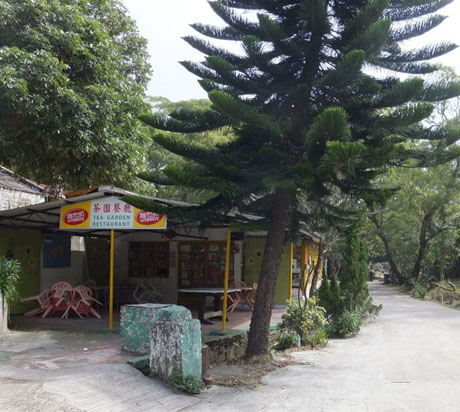
Tea Garden Restaurant, now permanently closed
WISDOM PATH
NGONG PING “WISDOM PATH” TEMPORARY CLOSURE - The
“Wisdom Path” at Ngong Ping will be closed for refurbishment work from 5th June 2025. It will gradually reopen in phases with final completion of
refurbishment expected to be in the final quarter of 2026.
Opened in 2005, the “Wisdom Path” comprises 38 vertical wooden columns (half tree-trunks), 8-10 metres tall and 1 metre wide, with inscribed 260-word verses from the Chinese version of Heart Sutra, one of the world’s best known prayers, revered by Buddhists, Taoists and Conficians alike. The pattern arrangement of the columns forms the symbol for infinity. Each column has a portion of a 260-word prayer inscribed on it and visitors follow the path around the columns, whilst reflecting.
During early - mid 2019 the Wisdom Path underwent improvement works with new facilities including a commemorative plaque for the late Professor Jao Tsung-I, a site map, benches, QR codes to allow easy access to the updated site information on the web, as well as improved trails and directional signage to bring more convenient, comfortable and fulfilling travel experience to members of the public and tourists. Visitors can better understand the history and background of the 'Wisdom Path' from the commemorative plaque which displays the biography and academic achievements of the late Professor Jao. Visitors can also scan the QR codes on the newly-added facilities and viewing platform with their mobile phones, which will redirect them to the Tourism Commission's website for the attraction, which has been revamped with new design and content with graphic illustration to introduce the "Wisdom Path";
https://www.tourism.gov.hk/wisdompath/en/index.html
Jao Tsung-I Petite Ecole of the University of Hong Kong and the Jao Studies Foundation provided assistance in the improvement works and the provision of the late Professor Jao's calligraphy and painting masterpieces, which have been incorporated them into the design of the newly-added commemorative plaque and site map. The late Professor Jao Tsung-I donated his original calligraphy featuring the "Prajna Paramita Hrdaya Sutra" (Heart Sutra) to the Hong Kong Special Administrative Region in 2002. The calligraphy was reproduced in the form of a large-scale outdoor wood inscription on a natural slope at the foot of Lantau Peak near Ngong Ping of Lantau Island. The timber columns, erected according to the mountain slope and integrated with the nature, became a unique large-scale outdoor art piece and was named as the "Wisdom Path".
The Wisdom Path can be located by following the well signed path which runs between the monastery and Buddha Statue, for about ten minutes past the abandoned Tea Gardens Restaurant.
Entry is free.
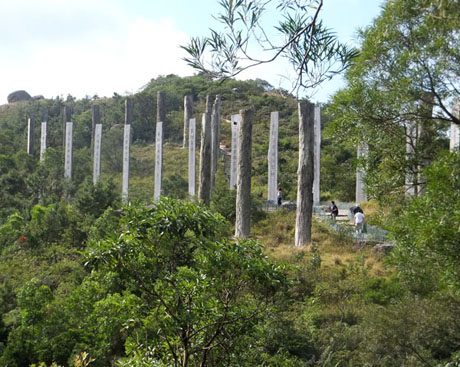
The timber columns making up the Wisdom Path. The columns are each inscribed in Chinese with extracts from verses from the Heart Sutra
Immediately beyond the entrance to the Wisdom Path, is an ornamental archway which marks the beginning of Stage 3 of the 70km Lantau Trail. Just beyond the archway is a viewing platform with views over the forested slopes to Shek Pik Reservoir and the south Lantau coast. Beyond the viewpoint the trail leads uphill to the towering Lantau Peak (also known as Fung Wong Shan and Phoenix Mountain), about one hour of mostly strenuous walking mostly via steps, from where on a clear day there are spectacular panoramic views as far as Macau.
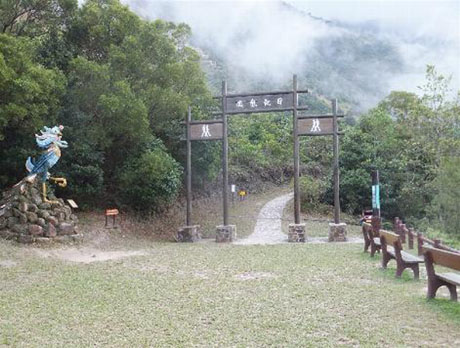
Next to the Wisdom Path, the arch and phoenix statue mark the start of Stage 3 of the Lantau Trail, leading to the typically misty summit of Hong Kong's second highest mountain, Lantau Peak also known as Phoenix Mountain
NGONG PING VIEWING PLATFORM
Opened in 2024 the Ngong Ping Viewing Platform is located about 15 minutes walk from the cable car terminus at Ngong Ping Village. Look for the direction signs to the viewing platform on the left on entering Ngong Ping Village after leaving the cable car terminus. The path which is part boardwalk and part stone trail also forms part of the Lantau Trail and offers spectacular views over Ngong Ping and the surrounding area and coastal views including the link road section of the Hong Kong – Zhuhai – Macau Bridge. Admission is free.
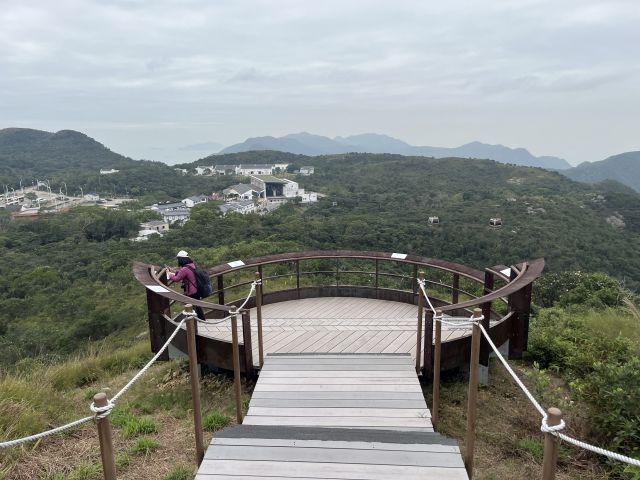
Ngong Ping Viewing Platform, opened in 2024
LOTUS POND TEMPLE
About 400-metres northwest of Po Lin Monastery on a scenic, tranquil site at the foot of mountains, Lotus Pond Temple is located at the site of Lin Chi Monastery which was established in 1921 by the Venerable Shi Ru. Since April 2011, Lotus Pond Temple has been the home of the Plum Village Foundation (Hong Kong) and, since 2012, the Asian Institute of Applied Buddhism (AIAB). The monastery is spread over a wide, flat area with a number of buildings.
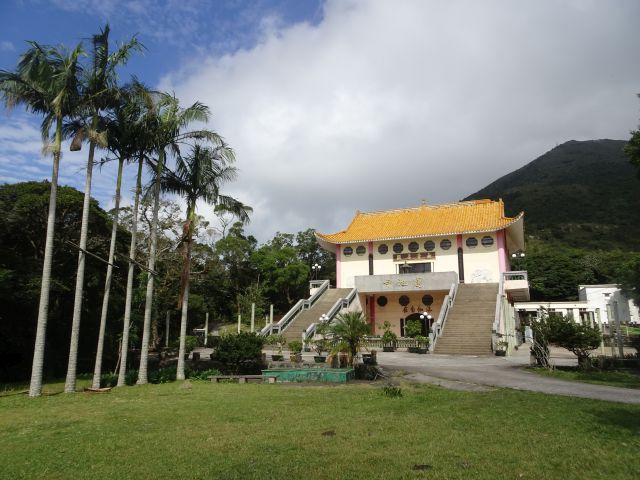
The peaceful and attractive Lotus Pond Temple is a short walk from Po Lin Monastery and the "Big Buddha" but off the beaten track for most visitors
The attractive main temple, Lotus Pond Temple, built in 1991, is a two-storey building with external stone staircases on both sides leading to the Amitayus Buddha Hall in the upper storey.
On the lower storey is the “Laka Guanyin” and a broad square in front of the main hall. The Lotus Pond Temple is a monastery for nuns, whilst the nearby Bamboo Forest Monastery (Chu Lam Ching Yun), also part of AIAB, is a monastery for monks. Weekly activities are held, which the public can attend and the monastery offers residential meditation retreats.
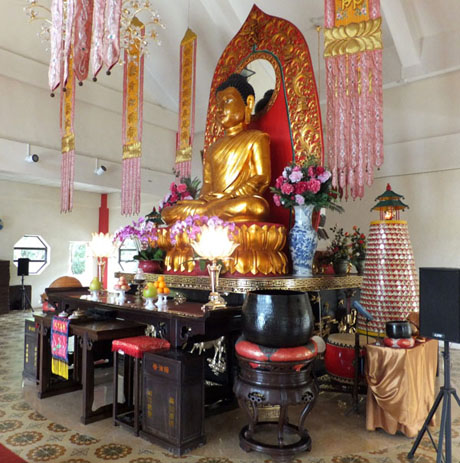
Amitayus Buddha Hall on the upper storey of Lotus Pond Temple
Although only a short walk from Ngong Ping’s other attractions, this temple, in complete contrast, is a quiet and peaceful retreat which is “off the beaten track” for most tourists. Lotus Pond Temple can be reached by following Lin Ping Drive (just ahead of the bus drop-off point at Ngong Ping) a short distance and then taking the path immediately on the left after Cheung Kee Café. The entrance gate is usually closed to keep out feral cattle but visitors are welcome to enter and look around the temple although there may be some restrictions when events are taking place.
NGONG PING SEWAGE TREATMENT INFORMATION CENTRE
Commissioned by the Drainage Services Department in 2006 and located on Ngong Ping Road, next to Ngong Ping Village, the treatment works serve a population of 40,000 including residents of Ngong Ping and tourists.
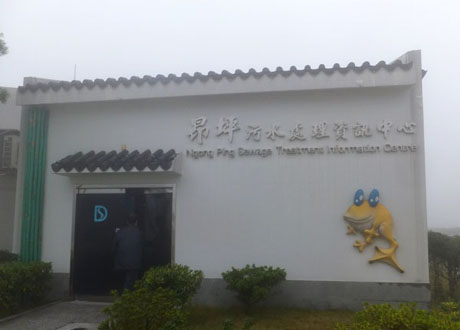
Ngong Ping Sewage Treatment Information Centre stands next to Ngong Ping Village on Ngong Ping Road
The plant treats about 450 cubic-metres of sewage a day and consumption of reclaimed water from the plant is about 140 cubic-metres a day. It has an information centre with small exhibition and fish ponds which use treated water from the plant.
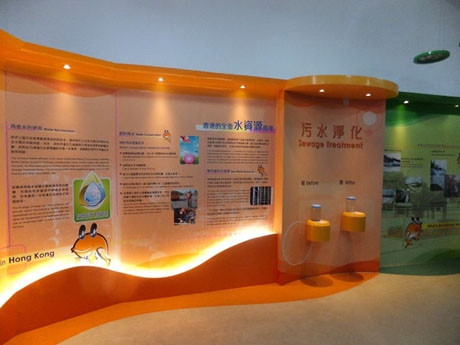
Display panels illustrate the sewage treatment process
The information centre is open to the public (free admission) on Tuesdays to Sundays from 10am to 12-30pm and 1-30pm to 4-30pm. It is closed on Mondays, New Year's Day, the first three days of Chinese New Year, Good Friday, Christmas Day and Boxing Day (Dec 26th).
For further information see;
https://www.dsd.gov.hk/EN/HTML/20517.html
GETTING TO NGONG PING;
NGONG PING 360 CABLE CAR - Ngong Ping Village is the upper terminus of the Ngong Ping 360 Cable Car service, linking the village with the town of Tung Chung near Hong Kong International Airport. The spectacular ride 5.7km ride across Tung Chung Bay and of Lantau Island takes 25 minutes. Operating hours on Monday to Friday are 10am to 6pm, Saturdays, Sundays and public holidays 9am to 6-30pm.
Tung Chung Cable Car Terminus is located about 3 minutes walk from exit B of Tung Chung MTR Station.
From Hong Kong International Airport, Tung Chung Cable Car Terminus is served by shuttle bus S1 (jointly operated by Citybus and Long Win Bus) from Cheong Tat Road outside the Terminal 1 Arrival Hall. The bus operates at about 5 minute frequency and the journey to the cable car terminus takes about 10 minutes.
The cable car service closes for scheduled servicing on several days a year and latest information can be found on the Ngong Ping 360 website;
http://www.np360.com.hk/en/visitors-information/np360-opening-hours.html
For more information see NGONG PING 360
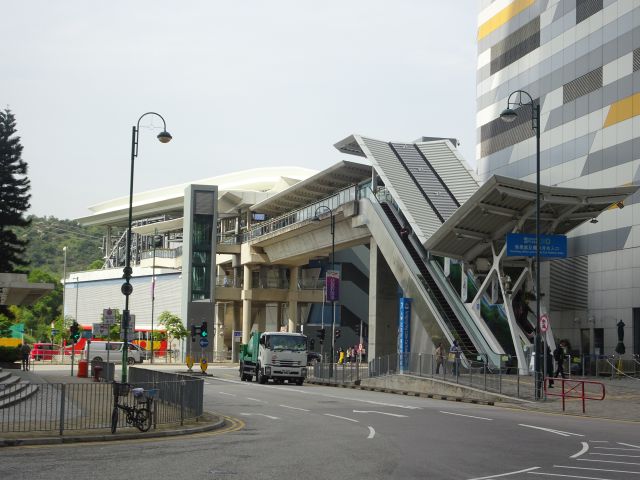
Escalators alongside Citygate Outlets Mall to entrance to Ngong Ping 360 Tung Chung Cable Car Terminus
BUS;
From Mui Wo Ferry Pier, Lantau Island - New Lantao Bus No 2 – Journey time about 40 minutes;
http://www.newlantaobus.com/route/detail/2
Mui Wo Ferry Pier is served by ferries operated by Sun Ferry which depart from Central Pier 6 on Hong Kong Island. There are two types of ferry, “Ordinary Ferry”, which is usually a double-deck ferry with open deck at the rear of the upper deck, journey time, about 55 mins and “Fast Ferry”, which is a fast catamaran, journey time about 30 mins. See timetable for details;
https://www.sunferry.com.hk/en/route-and-fare/timetable?route=central-to-mui-wo
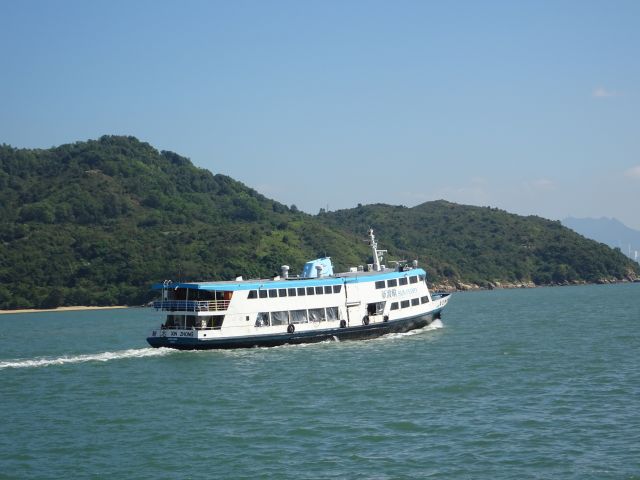
Central - Mui Wo double-deck ferry (officially known as the "Ordinary Ferry") departing from Mui Wo Ferry Pier. The journey to Mui Wo takes about 55 mins. Although slower than the "Fast Ferries" (catamarans), which make the journey in 30 mins, the Ordinary Ferry is much more suitable for tourists for sightseeing. At Mui Wo Ferry Pier, the bus connects with bus number 2 for Ngong Ping
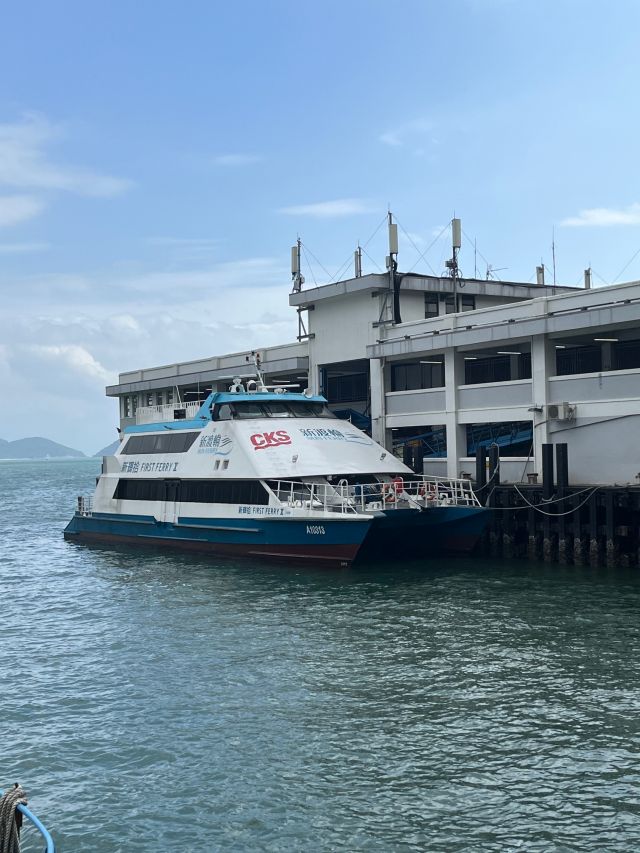
Sun Ferry "Fast Ferry" at Mui Wo Ferry Pier, December 2023
From Tung Chung, Lantau Island - New Lantao Bus No 23 – Journey time about 50 mins. An alternative to the cable car. The bus terminus at Tung Chung is about 3 minutes walk from exit B of Tung Chung MTR Station, located between Citygate Outlets mall and Tung Chung Cable Car Terminus*.
* with effect from 4th May 2015 the terminus for New Lantao Bus service 23 has been relocated to Tung Chung Temporary Bus Terminus on Tat Tung Road, adjacent to the Ngong Ping 360 cable car terminus;
http://www.newlantaobus.com/route/detail/7
From Tai O, Lantau Island – New Lantao Bus No 21 – Journey time about 15 mins. This service links Ngong Ping with the village of Tai O, another popular tourist destination on Lantau Island;
http://www.newlantaobus.com/route/detail/6
On Sundays and public holidays only New Lantao Bus service 1R operates from Hung Hom Station to Ngong Ping via Tsim Sha Tsui, Jordan, Yau Ma Tei, Mong Kok, Lantau Link and Tung Chung. There are three departures at 8-30am, 9-15am and 10am and the journey time is about 105 minutes;
http://www.newlantaobus.com/route/detail/3
TAXI;
Ngong Ping is served by blue (Lantau Island) taxi only. Approximate one-way fares to Ngong Ping from;
Tung Chung HK$210*
Hong Kong International Airport HK$255*
Mui Wo Ferry Pier HK$180*
Tai O HK$72*
*There is an additional charge of HK$6 for each item of large luggage carried in the taxi boot.
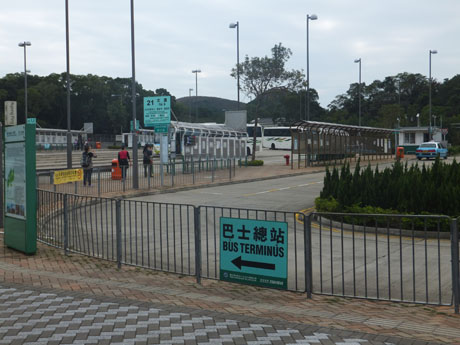
Ngong Ping Public Transport Interchange (bus and taxi stands) at Ngong Ping Village
WALKING TRAILS NGONG PING TO TUNG CHUNG
There are a number of popular scenic walking paths in the area and energetic visitors with 3 or 4 hours to spare can walk to Tung Chung as an alternative to public transport. These include a picturesque walk down the TUNG CHUNG VALLEY PATH alongside forested hills, streams, pavilions and shrines through ancient Tei Tong Tsai Village and Po Lam and Lo Hon monasteries which also allows the opportunity to visit Tung Chung Fort on the way. The walk is along concreted paths and is signposted from just beyond the Tea Garden Restaurant. To walk to Tung Chung Town Centre takes about two hours but the walk can be shortened to about 90 minutes once Tung Chung Road is reached where buses to Tung Chung and Mui Wo are available.
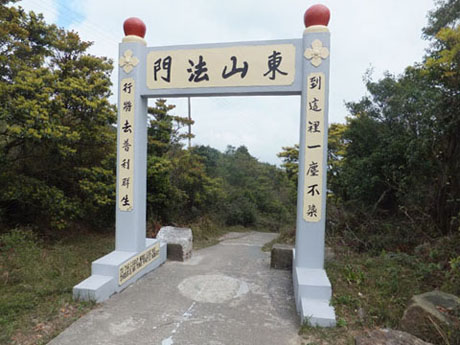
Just beyond the Tea Garden Restaurant, follow the path on the left signed "Tung Chung Town Centre" and about 8 minutes walking beyond is reached this cement gate at the beginning of the descent through the Tung Chung Valley to Tung Chung.
The scenic path wind its way through forested hillsides and past Po Lam Zen Monastery at Tei Tong Tsai and Lo Hon Monastery at Shek Mun Kap before reaching the high-rise apartment blocks on the outskirts of Tung Chung
A walk with a difference is the 5.7km NGONG PING 360 RESCUE TRAIL, which includes a short section of the Lantau Trail, and starts at the path leading off the service road just below the cable car terminus at Ngong Ping Village. This is a spectacular walk along the mountain tops under the path of the cable car and alongside the cable car towers and angle station. Construction of this trail in the mountainous terrain was a major challenge and six mules were brought in from Canada to assist in transporting materials. The trail comprises concrete paths, steps and timber boardwalks. There are some steep sets of steps to climb approaching some of the cable car towers and on valley sides and there are some undulating sections but much of the trail is level until reaching the rapid descent via steps down from Tower 3 to Tung Chung Bay. Allow 3.5 hours to walk to Tung Chung Town Centre by this route although again the walk can be shortened by taking a bus from Tung Chung Road near Tung Chung Fort or Yat Tung Estate.
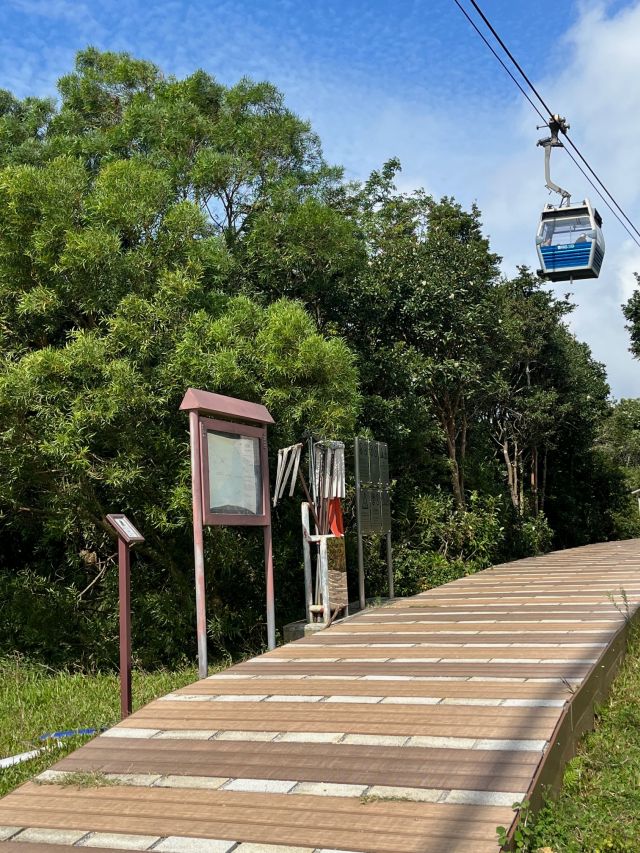
From just below Ngong Ping Cable Car Terminus, the Ngong Ping Rescue Trail is a stone and plank trail under the path of the cable car. The 5.7km trail was specially constructed for emergency access to the cable car and as a leisure facility. The scenic trails undulates over plateau and mountainous terrain before descending to Tung Chung Bay. Six mules were brought in from Canada to assist in carrying materials during its construction
NGONG PING ACCOMMODATION;
HONGKONG BANK FOUNDATION SG DAVIS HOSTEL - is run by Hong Kong Youth Hostels Association and has dormitory and double-room accommodation for both YHA members and non-members. Bookings can be made up to 3 months in advance. The hostel is located near the “Big Buddha” just beyond the Tea Gardens Restaurant. For further information and bookings see website;
https://www.yha.org.hk/en/hostel/yha-ngong-ping-sg-davis-youth-hostel/
ACCOMMODATION NEARBY AT TAI O;
ESPACE ELASTIQUE - B&B accommodation on top floor of a cafe/gallery
https://espaceelastique.com.hk/
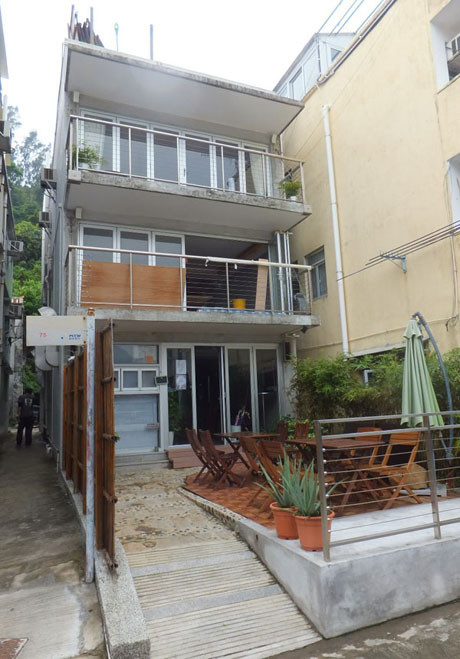
Espace Elastique, B & B accommodation at nearby Tai O
SOLO LODGE GUEST HOUSE - Two 2-bedroom houses accommodating up to 4 people and one 2-bedroom guest house accommodating 4-6 people. Kitchen facilities, BBQ, bicycle, cot. Rates from HK$300 up (1- bedroom Sunday to Friday) to HK$900 (2-bedrooms Saturdays and public holidays). Owners also operate Solo Cafe.
Reception - 86 Kat Hing Front Street, Tai O.
Phone - (852) 9349 9147 (Chinese), (852) 9153 7453 (English)
E-mail - taiosolo@gmail.com
TAI O HERITAGE HOTEL - 9-room boutique hotel, opened March 2012, in magnificently renovated historic old colonial police station. Developed by Hong Kong Heritage Conservation Foundation and operating as a non-profit making social enterprise. The two-storey main block, outhouse extension, bunkers, cannons and guard towers have all been restored to their original appearance. Hotel also has a Heritage Interpretation Centre, open to the public;
http://www.taioheritagehotel.com/eng/homepage/ShowGallery 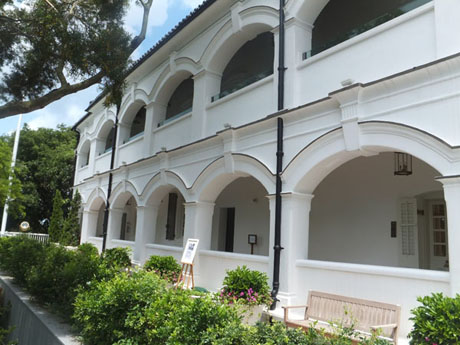
Tai O Heritage Hotel, the splendidly restored colonial Old Tai O Police Station